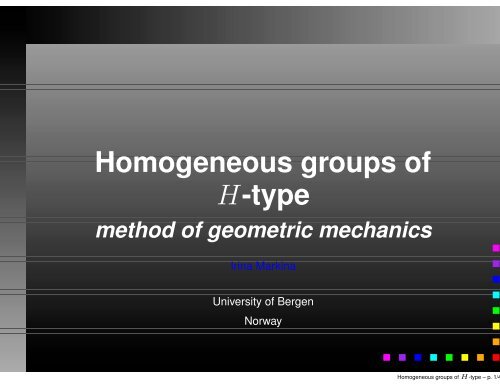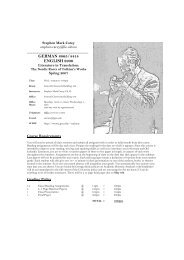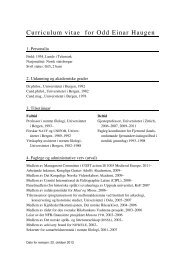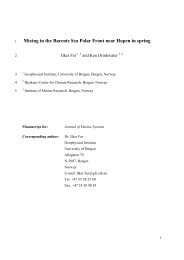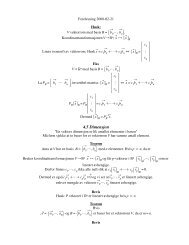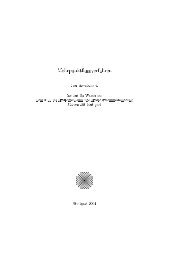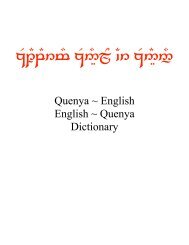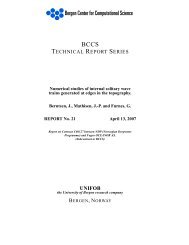Homogeneous groups of H-type
Homogeneous groups of H-type
Homogeneous groups of H-type
You also want an ePaper? Increase the reach of your titles
YUMPU automatically turns print PDFs into web optimized ePapers that Google loves.
<strong>Homogeneous</strong> <strong>groups</strong> <strong>of</strong><br />
H-<strong>type</strong><br />
method <strong>of</strong> geometric mechanics<br />
Irina Markina<br />
University <strong>of</strong> Bergen<br />
Norway<br />
<strong>Homogeneous</strong> <strong>groups</strong> <strong>of</strong> H-<strong>type</strong> – p. 1/4
Contents:<br />
• General definitions <strong>of</strong> homogeneous <strong>groups</strong><br />
<strong>of</strong> H-<strong>type</strong><br />
<strong>Homogeneous</strong> <strong>groups</strong> <strong>of</strong> H-<strong>type</strong> – p. 2/4
Contents:<br />
• General definitions <strong>of</strong> homogeneous <strong>groups</strong><br />
<strong>of</strong> H-<strong>type</strong><br />
• Construction <strong>of</strong> <strong>groups</strong> satisfying the J 2<br />
condition<br />
<strong>Homogeneous</strong> <strong>groups</strong> <strong>of</strong> H-<strong>type</strong> – p. 2/4
Contents:<br />
• General definitions <strong>of</strong> homogeneous <strong>groups</strong><br />
<strong>of</strong> H-<strong>type</strong><br />
• Construction <strong>of</strong> <strong>groups</strong> satisfying the J 2<br />
condition<br />
• Example: quaternion group<br />
<strong>Homogeneous</strong> <strong>groups</strong> <strong>of</strong> H-<strong>type</strong> – p. 2/4
Definitions<br />
Let<br />
• G be a real Lie algebra,<br />
<strong>Homogeneous</strong> <strong>groups</strong> <strong>of</strong> H-<strong>type</strong> – p. 3/4
Definitions<br />
Let<br />
• G be a real Lie algebra,<br />
• 〈·, ·〉 scalar product,<br />
<strong>Homogeneous</strong> <strong>groups</strong> <strong>of</strong> H-<strong>type</strong> – p. 3/4
Definitions<br />
Let<br />
• G be a real Lie algebra,<br />
• 〈·, ·〉 scalar product,<br />
• [·, ·] Lie brackets,<br />
<strong>Homogeneous</strong> <strong>groups</strong> <strong>of</strong> H-<strong>type</strong> – p. 3/4
Definitions<br />
Let<br />
• G be a real Lie algebra,<br />
• 〈·, ·〉 scalar product,<br />
• [·, ·] Lie brackets,<br />
• G = V1 ⊕ V2, orthogonal direct sum,<br />
<strong>Homogeneous</strong> <strong>groups</strong> <strong>of</strong> H-<strong>type</strong> – p. 3/4
Definitions<br />
Let<br />
• G be a real Lie algebra,<br />
• 〈·, ·〉 scalar product,<br />
• [·, ·] Lie brackets,<br />
• G = V1 ⊕ V2, orthogonal direct sum,<br />
• [V1, V1] ⊆ V2 and [V1, V2] = [V2, V2] = 0.<br />
<strong>Homogeneous</strong> <strong>groups</strong> <strong>of</strong> H-<strong>type</strong> – p. 3/4
Definitions<br />
If there is a linear map J : V2 → End(V1)<br />
• 〈JZX, X ′ 〉 = 〈Z, [X, X ′ ]〉,<br />
∀ X, X ′ ∈ V1, ∀ Z ∈ V2,<br />
<strong>Homogeneous</strong> <strong>groups</strong> <strong>of</strong> H-<strong>type</strong> – p. 4/4
Definitions<br />
If there is a linear map J : V2 → End(V1)<br />
• 〈JZX, X ′ 〉 = 〈Z, [X, X ′ ]〉,<br />
∀ X, X ′ ∈ V1, ∀ Z ∈ V2,<br />
• J T Z = −JZ, ∀ Z ∈ V2,<br />
<strong>Homogeneous</strong> <strong>groups</strong> <strong>of</strong> H-<strong>type</strong> – p. 4/4
Definitions<br />
If there is a linear map J : V2 → End(V1)<br />
• 〈JZX, X ′ 〉 = 〈Z, [X, X ′ ]〉,<br />
∀ X, X ′ ∈ V1, ∀ Z ∈ V2,<br />
• J T Z = −JZ, ∀ Z ∈ V2,<br />
• J 2 Z = −|Z|2 U, ∀ Z ∈ V2, U is the identity,<br />
<strong>Homogeneous</strong> <strong>groups</strong> <strong>of</strong> H-<strong>type</strong> – p. 4/4
Definitions<br />
If there is a linear map J : V2 → End(V1)<br />
• 〈JZX, X ′ 〉 = 〈Z, [X, X ′ ]〉,<br />
∀ X, X ′ ∈ V1, ∀ Z ∈ V2,<br />
• J T Z = −JZ, ∀ Z ∈ V2,<br />
• J 2 Z = −|Z|2 U, ∀ Z ∈ V2, U is the identity,<br />
• we say G is H-<strong>type</strong>.<br />
<strong>Homogeneous</strong> <strong>groups</strong> <strong>of</strong> H-<strong>type</strong> – p. 4/4
J 2 condition<br />
G satisfies the J 2 condition if, whenever<br />
X ∈ V1 and Z, Z ′ ∈ V2 with 〈Z, Z ′ 〉 = 0,<br />
there exists Z ′′ in V2, such that<br />
<strong>Homogeneous</strong> <strong>groups</strong> <strong>of</strong> H-<strong>type</strong> – p. 5/4
J 2 condition<br />
G satisfies the J 2 condition if, whenever<br />
X ∈ V1 and Z, Z ′ ∈ V2 with 〈Z, Z ′ 〉 = 0,<br />
there exists Z ′′ in V2, such that<br />
JZJZ ′X = JZ ′′X.<br />
<strong>Homogeneous</strong> <strong>groups</strong> <strong>of</strong> H-<strong>type</strong> – p. 5/4
Classification<br />
• R n 0, k ∈ N, is Euclidean space<br />
<strong>Homogeneous</strong> <strong>groups</strong> <strong>of</strong> H-<strong>type</strong> – p. 6/4
Classification<br />
• R n 0, k ∈ N, is Euclidean space<br />
• G n 1 , n = 2k, k ∈ N, is Heisenberg algebra<br />
<strong>Homogeneous</strong> <strong>groups</strong> <strong>of</strong> H-<strong>type</strong> – p. 6/4
Classification<br />
• R n 0, k ∈ N, is Euclidean space<br />
• G n 1 , n = 2k, k ∈ N, is Heisenberg algebra<br />
• G n 3 , n = 4k, k ∈ N, is quaternion algebra<br />
<strong>Homogeneous</strong> <strong>groups</strong> <strong>of</strong> H-<strong>type</strong> – p. 6/4
Classification<br />
• R n 0, k ∈ N, is Euclidean space<br />
• G n 1 , n = 2k, k ∈ N, is Heisenberg algebra<br />
• G n 3 , n = 4k, k ∈ N, is quaternion algebra<br />
• G 8 7 is octonion algebra.<br />
<strong>Homogeneous</strong> <strong>groups</strong> <strong>of</strong> H-<strong>type</strong> – p. 6/4
Classification<br />
• R n 0, k ∈ N, is Euclidean space<br />
• G n 1 , n = 2k, k ∈ N, is Heisenberg algebra<br />
• G n 3 , n = 4k, k ∈ N, is quaternion algebra<br />
• G 8 7 is octonion algebra.<br />
• Cowling M.; Dooley A. H.; Korányi A.; Ricci F. H-<strong>type</strong> <strong>groups</strong> and Iwasawa<br />
decompositions. Adv. Math. 87 (1991), no. 1, 1–41.<br />
<strong>Homogeneous</strong> <strong>groups</strong> <strong>of</strong> H-<strong>type</strong> – p. 6/4
Cayley-Dickson construction<br />
• What are real numbers R?<br />
<strong>Homogeneous</strong> <strong>groups</strong> <strong>of</strong> H-<strong>type</strong> – p. 7/4
Cayley-Dickson construction<br />
• What are real numbers R?<br />
• What are complex numbers C?<br />
<strong>Homogeneous</strong> <strong>groups</strong> <strong>of</strong> H-<strong>type</strong> – p. 7/4
Cayley-Dickson construction<br />
• What are real numbers R?<br />
• What are complex numbers C?<br />
• It is a pair (a, b) <strong>of</strong> real numbers a, b ∈ R,<br />
<strong>Homogeneous</strong> <strong>groups</strong> <strong>of</strong> H-<strong>type</strong> – p. 7/4
Cayley-Dickson construction<br />
• What are real numbers R?<br />
• What are complex numbers C?<br />
• It is a pair (a, b) <strong>of</strong> real numbers a, b ∈ R,<br />
• a ∗ = a conjugate to a real number,<br />
<strong>Homogeneous</strong> <strong>groups</strong> <strong>of</strong> H-<strong>type</strong> – p. 7/4
Cayley-Dickson construction<br />
• What are real numbers R?<br />
• What are complex numbers C?<br />
• It is a pair (a, b) <strong>of</strong> real numbers a, b ∈ R,<br />
• a ∗ = a conjugate to a real number,<br />
• (a, b) ∗ = (a ∗ , −b) is conjugate to a complex<br />
number,<br />
<strong>Homogeneous</strong> <strong>groups</strong> <strong>of</strong> H-<strong>type</strong> – p. 7/4
Cayley-Dickson construction<br />
• What are real numbers R?<br />
• What are complex numbers C?<br />
• It is a pair (a, b) <strong>of</strong> real numbers a, b ∈ R,<br />
• a ∗ = a conjugate to a real number,<br />
• (a, b) ∗ = (a ∗ , −b) is conjugate to a complex<br />
number,<br />
• multiplication (a, b)(c, d) = (ac − db ∗ , a ∗ d + cb).<br />
<strong>Homogeneous</strong> <strong>groups</strong> <strong>of</strong> H-<strong>type</strong> – p. 7/4
Quaternions H<br />
• It is a pair (a, b) <strong>of</strong> complex numbers a, b ∈ C,<br />
<strong>Homogeneous</strong> <strong>groups</strong> <strong>of</strong> H-<strong>type</strong> – p. 8/4
Quaternions H<br />
• It is a pair (a, b) <strong>of</strong> complex numbers a, b ∈ C,<br />
• (a, b) ∗ = (a ∗ , −b) is conjugate to a quaternion,<br />
<strong>Homogeneous</strong> <strong>groups</strong> <strong>of</strong> H-<strong>type</strong> – p. 8/4
Quaternions H<br />
• It is a pair (a, b) <strong>of</strong> complex numbers a, b ∈ C,<br />
• (a, b) ∗ = (a ∗ , −b) is conjugate to a quaternion,<br />
• with the multiplication<br />
(a, b)(c, d) = (ac − db ∗ , a ∗ d + cb).<br />
<strong>Homogeneous</strong> <strong>groups</strong> <strong>of</strong> H-<strong>type</strong> – p. 8/4
Octonions O<br />
• It is a pair (a, b) <strong>of</strong> quaternion numbers<br />
a, b ∈ H,<br />
<strong>Homogeneous</strong> <strong>groups</strong> <strong>of</strong> H-<strong>type</strong> – p. 9/4
Octonions O<br />
• It is a pair (a, b) <strong>of</strong> quaternion numbers<br />
a, b ∈ H,<br />
• (a, b) ∗ = (a ∗ , −b) is conjugate to an octonion,<br />
<strong>Homogeneous</strong> <strong>groups</strong> <strong>of</strong> H-<strong>type</strong> – p. 9/4
Octonions O<br />
• It is a pair (a, b) <strong>of</strong> quaternion numbers<br />
a, b ∈ H,<br />
• (a, b) ∗ = (a ∗ , −b) is conjugate to an octonion,<br />
• with the multiplication<br />
(a, b)(c, d) = (ac − db ∗ , a ∗ d + cb).<br />
<strong>Homogeneous</strong> <strong>groups</strong> <strong>of</strong> H-<strong>type</strong> – p. 9/4
Octonions O<br />
• It is a pair (a, b) <strong>of</strong> quaternion numbers<br />
a, b ∈ H,<br />
• (a, b) ∗ = (a ∗ , −b) is conjugate to an octonion,<br />
• with the multiplication<br />
• . . .<br />
(a, b)(c, d) = (ac − db ∗ , a ∗ d + cb).<br />
<strong>Homogeneous</strong> <strong>groups</strong> <strong>of</strong> H-<strong>type</strong> – p. 9/4
Properties we loose<br />
• R division algebra, associative, commutative,<br />
self conjugate,<br />
<strong>Homogeneous</strong> <strong>groups</strong> <strong>of</strong> H-<strong>type</strong> – p. 10/4
Properties we loose<br />
• R division algebra, associative, commutative,<br />
self conjugate,<br />
• C division algebra, associative, commutative,<br />
<strong>Homogeneous</strong> <strong>groups</strong> <strong>of</strong> H-<strong>type</strong> – p. 10/4
Properties we loose<br />
• R division algebra, associative, commutative,<br />
self conjugate,<br />
• C division algebra, associative, commutative,<br />
• H division algebra, associative,<br />
<strong>Homogeneous</strong> <strong>groups</strong> <strong>of</strong> H-<strong>type</strong> – p. 10/4
Properties we loose<br />
• R division algebra, associative, commutative,<br />
self conjugate,<br />
• C division algebra, associative, commutative,<br />
• H division algebra, associative,<br />
• O division algebra,<br />
<strong>Homogeneous</strong> <strong>groups</strong> <strong>of</strong> H-<strong>type</strong> – p. 10/4
Properties we loose<br />
• R division algebra, associative, commutative,<br />
self conjugate,<br />
• C division algebra, associative, commutative,<br />
• H division algebra, associative,<br />
• O division algebra,<br />
• if xy = 0, then x = 0 or y = 0.<br />
<strong>Homogeneous</strong> <strong>groups</strong> <strong>of</strong> H-<strong>type</strong> – p. 10/4
Unities<br />
• R has only one 1 = (1, 0), 1 2 = 1.<br />
Imaginary part has dimension 0.<br />
<strong>Homogeneous</strong> <strong>groups</strong> <strong>of</strong> H-<strong>type</strong> – p. 11/4
Unities<br />
• R has only one 1 = (1, 0), 1 2 = 1.<br />
Imaginary part has dimension 0.<br />
• C: 1 = (1, 0), 1 2 = 1 and i = (0, 1), i 2 = −1.<br />
Imaginary part has dimension 1.<br />
z = a + ib = Re z + i Im z, a, b ∈ R.<br />
<strong>Homogeneous</strong> <strong>groups</strong> <strong>of</strong> H-<strong>type</strong> – p. 11/4
Unities<br />
• H: 1 = (1, 0), 1 2 = 1 and<br />
i1 = (i, 0), i2 = (0, 1), i3 = (0, i),<br />
i 2 1 = i 2 2 = i 2 3 = −1.<br />
<strong>Homogeneous</strong> <strong>groups</strong> <strong>of</strong> H-<strong>type</strong> – p. 12/4
Unities<br />
• H: 1 = (1, 0), 1 2 = 1 and<br />
i1 = (i, 0), i2 = (0, 1), i3 = (0, i),<br />
i 2 1 = i 2 2 = i 2 3 = −1.<br />
• q = a + i1b + i2c + i3d =<br />
Re q + i1 Im1 q + i2 Im2 q + i3 Im3 q,<br />
a, b, c, d ∈ R.<br />
<strong>Homogeneous</strong> <strong>groups</strong> <strong>of</strong> H-<strong>type</strong> – p. 12/4
Unities<br />
O: 1 = (1, 0), 1 2 = 1 and<br />
with<br />
j1 = (i1, 0), j2 = (i2, 0), j3 = (i3, 0),<br />
j4 = (0, 1), j5 = (0, i1) j6 = (0, i2), j7 = (0, i3),<br />
j 2 1 = j 2 2 = j 2 3 = j 2 4 = j 2 5 = j 2 6 = j 2 7 = −1.<br />
Imaginary part has dimension 7.<br />
<strong>Homogeneous</strong> <strong>groups</strong> <strong>of</strong> H-<strong>type</strong> – p. 13/4
R n (R n 0)<br />
R n 0 = V1 ⊕ V2 with V1 = R n and V2 = ∅.<br />
<strong>Homogeneous</strong> <strong>groups</strong> <strong>of</strong> H-<strong>type</strong> – p. 14/4
Heisenberg group G n 1 (C n ×R)<br />
• z = (x, y) ∈ C, t ∈ R,<br />
<strong>Homogeneous</strong> <strong>groups</strong> <strong>of</strong> H-<strong>type</strong> – p. 15/4
Heisenberg group G n 1 (C n ×R)<br />
• z = (x, y) ∈ C, t ∈ R,<br />
• w = (a, b) ∈ C, s ∈ R<br />
<strong>Homogeneous</strong> <strong>groups</strong> <strong>of</strong> H-<strong>type</strong> – p. 15/4
Heisenberg group G n 1 (C n ×R)<br />
• z = (x, y) ∈ C, t ∈ R,<br />
• w = (a, b) ∈ C, s ∈ R<br />
• (z, t) ◦ (w, s) = (z + w, t + s + Im zw ∗ ) =<br />
(z + w, t + s + iz · w) = (z + w, t + s + J z · w),<br />
<strong>Homogeneous</strong> <strong>groups</strong> <strong>of</strong> H-<strong>type</strong> – p. 15/4
Heisenberg group G n 1 (C n ×R)<br />
• z = (x, y) ∈ C, t ∈ R,<br />
• w = (a, b) ∈ C, s ∈ R<br />
• (z, t) ◦ (w, s) = (z + w, t + s + Im zw ∗ ) =<br />
(z + w, t + s + iz · w) = (z + w, t + s + J z · w),<br />
where<br />
J<br />
<br />
0 −1<br />
<br />
= .<br />
1 0<br />
<strong>Homogeneous</strong> <strong>groups</strong> <strong>of</strong> H-<strong>type</strong> – p. 15/4
Heisenberg group G n 1 (C n ×R)<br />
• z = (x, y) ∈ C, t ∈ R,<br />
• w = (a, b) ∈ C, s ∈ R<br />
• (z, t) ◦ (w, s) = (z + w, t + s + Im zw ∗ ) =<br />
(z + w, t + s + iz · w) = (z + w, t + s + J z · w),<br />
where<br />
J<br />
<br />
0 −1<br />
<br />
= .<br />
1 0<br />
<strong>Homogeneous</strong> <strong>groups</strong> <strong>of</strong> H-<strong>type</strong> – p. 15/4
Quaternion H-<strong>type</strong> group G n 3<br />
(H n × R 3 )<br />
• q ∈ H, t1, t2, t3 ∈ R,<br />
<strong>Homogeneous</strong> <strong>groups</strong> <strong>of</strong> H-<strong>type</strong> – p. 16/4
Quaternion H-<strong>type</strong> group G n 3<br />
(H n × R 3 )<br />
• q ∈ H, t1, t2, t3 ∈ R,<br />
• h ∈ H, s1, s2, s3 ∈ R<br />
<strong>Homogeneous</strong> <strong>groups</strong> <strong>of</strong> H-<strong>type</strong> – p. 16/4
Quaternion H-<strong>type</strong> group G n 3<br />
(H n × R 3 )<br />
• q ∈ H, t1, t2, t3 ∈ R,<br />
• h ∈ H, s1, s2, s3 ∈ R<br />
• (q, t1, t2, t3) ◦ (h, s1, s2, s3) = (q + h,<br />
<strong>Homogeneous</strong> <strong>groups</strong> <strong>of</strong> H-<strong>type</strong> – p. 16/4
Quaternion H-<strong>type</strong> group G n 3<br />
(H n × R 3 )<br />
• q ∈ H, t1, t2, t3 ∈ R,<br />
• h ∈ H, s1, s2, s3 ∈ R<br />
• (q, t1, t2, t3) ◦ (h, s1, s2, s3) = (q + h,<br />
• t1 + s1 + Im1 qh ∗ , t2 + s2 + Im2 qh ∗ , t3 + s3 +<br />
Im3 qh ∗ ) =<br />
<strong>Homogeneous</strong> <strong>groups</strong> <strong>of</strong> H-<strong>type</strong> – p. 16/4
Quaternion H-<strong>type</strong> group G n 3<br />
(H n × R 3 )<br />
• q ∈ H, t1, t2, t3 ∈ R,<br />
• h ∈ H, s1, s2, s3 ∈ R<br />
• (q, t1, t2, t3) ◦ (h, s1, s2, s3) = (q + h,<br />
• t1 + s1 + Im1 qh ∗ , t2 + s2 + Im2 qh ∗ , t3 + s3 +<br />
Im3 qh ∗ ) =<br />
• (q + h, t1 + s1 + i1q · h, t2 + s2 + i2q · h, t3 + s3 +<br />
i3q · h) =<br />
<strong>Homogeneous</strong> <strong>groups</strong> <strong>of</strong> H-<strong>type</strong> – p. 16/4
Quaternion H-<strong>type</strong> group G n 3<br />
(q + h, t1 + s1 + J1q · h, t2 + s2 + J2q · h, t3 + s3 + J3q · h),<br />
<strong>Homogeneous</strong> <strong>groups</strong> <strong>of</strong> H-<strong>type</strong> – p. 17/4
Quaternion H-<strong>type</strong> group G n 3<br />
(q + h, t1 + s1 + J1q · h, t2 + s2 + J2q · h, t3 + s3 + J3q · h),<br />
J1 =<br />
⎡<br />
⎢<br />
⎣<br />
0 1 0 0<br />
−1 0 0 0<br />
0 0 0 1<br />
0 0 −1 0<br />
⎤<br />
⎡<br />
⎥ ⎢<br />
⎥ ⎢<br />
⎥ ⎢<br />
⎥ ⎢<br />
⎥ ⎢<br />
⎥ ⎢<br />
⎥ ⎢<br />
⎥ , J2 = ⎢<br />
⎥ ⎢<br />
⎥ ⎢<br />
⎥ ⎢<br />
⎥ ⎢<br />
⎥ ⎢<br />
⎦ ⎣<br />
0 0 0 −1<br />
0 0 −1 0<br />
0 1 0 0<br />
1 0 0 0<br />
⎤<br />
⎡<br />
⎥ ⎢<br />
⎥ ⎢<br />
⎥ ⎢<br />
⎥ ⎢<br />
⎥ ⎢<br />
⎥ ⎢<br />
⎥ ⎢<br />
⎥ , J3 = ⎢<br />
⎥ ⎢<br />
⎥ ⎢<br />
⎥ ⎢<br />
⎥ ⎢<br />
⎥ ⎢<br />
⎦ ⎣<br />
0 0 −1 0<br />
0 0 0 1<br />
1 0 0 0<br />
0 −1 0 0<br />
⎤<br />
⎥ .<br />
⎥<br />
⎦<br />
<strong>Homogeneous</strong> <strong>groups</strong> <strong>of</strong> H-<strong>type</strong> – p. 17/4
Octonion H-<strong>type</strong> group G 1 7<br />
(O × R 7 )<br />
• p ∈ O, t = (t1, . . . , t7) ∈ R 7 ,<br />
<strong>Homogeneous</strong> <strong>groups</strong> <strong>of</strong> H-<strong>type</strong> – p. 18/4
Octonion H-<strong>type</strong> group G 1 7<br />
(O × R 7 )<br />
• p ∈ O, t = (t1, . . . , t7) ∈ R 7 ,<br />
• r ∈ O, s = (s1, . . . , s7) ∈ R 7 .<br />
<strong>Homogeneous</strong> <strong>groups</strong> <strong>of</strong> H-<strong>type</strong> – p. 18/4
Octonion H-<strong>type</strong> group G 1 7<br />
(O × R 7 )<br />
• p ∈ O, t = (t1, . . . , t7) ∈ R 7 ,<br />
• r ∈ O, s = (s1, . . . , s7) ∈ R 7 .<br />
• (p, t) ◦ (r, s) = (p + r, t + s + Im pr ∗ ),<br />
<strong>Homogeneous</strong> <strong>groups</strong> <strong>of</strong> H-<strong>type</strong> – p. 18/4
Octonion H-<strong>type</strong> group G 1 7<br />
(O × R 7 )<br />
• p ∈ O, t = (t1, . . . , t7) ∈ R 7 ,<br />
• r ∈ O, s = (s1, . . . , s7) ∈ R 7 .<br />
• (p, t) ◦ (r, s) = (p + r, t + s + Im pr ∗ ),<br />
• where Im pr ∗ = (Im1 pr ∗ , . . . , Im7 pr ∗ ).<br />
<strong>Homogeneous</strong> <strong>groups</strong> <strong>of</strong> H-<strong>type</strong> – p. 18/4
Octonion H-<strong>type</strong> group G 1 7<br />
(O × R 7 )<br />
• p ∈ O, t = (t1, . . . , t7) ∈ R 7 ,<br />
• r ∈ O, s = (s1, . . . , s7) ∈ R 7 .<br />
• (p, t) ◦ (r, s) = (p + r, t + s + Im pr ∗ ),<br />
• where Im pr ∗ = (Im1 pr ∗ , . . . , Im7 pr ∗ ).<br />
• (p, t) ◦ (r, s) = (p + r, t + s + Jp · r),<br />
<strong>Homogeneous</strong> <strong>groups</strong> <strong>of</strong> H-<strong>type</strong> – p. 18/4
Octonion H-<strong>type</strong> group G 1 7<br />
(O × R 7 )<br />
• p ∈ O, t = (t1, . . . , t7) ∈ R 7 ,<br />
• r ∈ O, s = (s1, . . . , s7) ∈ R 7 .<br />
• (p, t) ◦ (r, s) = (p + r, t + s + Im pr ∗ ),<br />
• where Im pr ∗ = (Im1 pr ∗ , . . . , Im7 pr ∗ ).<br />
• (p, t) ◦ (r, s) = (p + r, t + s + Jp · r),<br />
• where J = (j1, . . . , j7).<br />
<strong>Homogeneous</strong> <strong>groups</strong> <strong>of</strong> H-<strong>type</strong> – p. 18/4
H-<strong>type</strong> group<br />
• (0, 0) is the neutral element,<br />
<strong>Homogeneous</strong> <strong>groups</strong> <strong>of</strong> H-<strong>type</strong> – p. 19/4
H-<strong>type</strong> group<br />
• (0, 0) is the neutral element,<br />
• (x, t) ↣ (−x, −t) is the inverse element.<br />
<strong>Homogeneous</strong> <strong>groups</strong> <strong>of</strong> H-<strong>type</strong> – p. 19/4
H-<strong>type</strong> group<br />
• (0, 0) is the neutral element,<br />
• (x, t) ↣ (−x, −t) is the inverse element.<br />
• If p = (x, t) and r = (y, s), then<br />
is the left translation.<br />
Lp(r) = p ◦ r<br />
<strong>Homogeneous</strong> <strong>groups</strong> <strong>of</strong> H-<strong>type</strong> – p. 19/4
H-<strong>type</strong> algebras<br />
The Lie algebra is associated with the left<br />
invariant vector fields<br />
X(p) = X(x, t) = Al(p)∂xl + Bm(p)∂tm:<br />
X(p) = (Lp)∗X(0).<br />
<strong>Homogeneous</strong> <strong>groups</strong> <strong>of</strong> H-<strong>type</strong> – p. 20/4
H-<strong>type</strong> algebras<br />
The Lie algebra is associated with the left<br />
invariant vector fields<br />
X(p) = X(x, t) = Al(p)∂xl + Bm(p)∂tm:<br />
X(p) = (Lp)∗X(0).<br />
X(p) = d<br />
f(p ◦ γ(s))|s=0,<br />
ds<br />
γ(0) = 0, d<br />
ds γ(s)|s=0 = X(0).<br />
<strong>Homogeneous</strong> <strong>groups</strong> <strong>of</strong> H-<strong>type</strong> – p. 20/4
Heisenberg algebra G n 1<br />
• Basis <strong>of</strong> G n 1<br />
X1 = ∂x1 − x2∂t, X2 = ∂x2<br />
T = ∂t<br />
+ x1∂t,<br />
<strong>Homogeneous</strong> <strong>groups</strong> <strong>of</strong> H-<strong>type</strong> – p. 21/4
Heisenberg algebra G n 1<br />
• Basis <strong>of</strong> G n 1<br />
X1 = ∂x1 − x2∂t, X2 = ∂x2<br />
T = ∂t<br />
• [X1, X2] = X1X2 − X2X1 = 2T<br />
+ x1∂t,<br />
<strong>Homogeneous</strong> <strong>groups</strong> <strong>of</strong> H-<strong>type</strong> – p. 21/4
Heisenberg algebra G n 1<br />
• Basis <strong>of</strong> G n 1<br />
X1 = ∂x1 − x2∂t, X2 = ∂x2<br />
T = ∂t<br />
• [X1, X2] = X1X2 − X2X1 = 2T<br />
• G n 1 = V1 ⊕ V2,<br />
+ x1∂t,<br />
V1 = span{X1, X2}, V2 = span{T }.<br />
<strong>Homogeneous</strong> <strong>groups</strong> <strong>of</strong> H-<strong>type</strong> – p. 21/4
Quaternions algebra G n 3<br />
• Basis <strong>of</strong> G n 3<br />
X1(x, t) =∂x1 + + x2∂t1<br />
X2(x, t) =∂x2 + − x1∂t1<br />
X3(x, t) =∂x3 + + x4∂t1<br />
X4(x, z) =∂x4 + − x3∂t1<br />
<br />
− x4∂t2 − x3∂t3 ,<br />
<br />
− x3∂t2 + x4∂t3 ,<br />
<br />
+ x2∂t2 + x1∂t3 ,<br />
<br />
+ x1∂t2 − x2∂t3 .<br />
<strong>Homogeneous</strong> <strong>groups</strong> <strong>of</strong> H-<strong>type</strong> – p. 22/4
Quaternions algebra G n 3<br />
• Basis <strong>of</strong> G n 3<br />
X1(x, t) =∂x1 + + x2∂t1<br />
X2(x, t) =∂x2 + − x1∂t1<br />
X3(x, t) =∂x3 + + x4∂t1<br />
X4(x, z) =∂x4 + − x3∂t1<br />
• T1 = ∂t1 , T2 = ∂t2 , T3 = ∂t3 .<br />
<br />
− x4∂t2 − x3∂t3 ,<br />
<br />
− x3∂t2 + x4∂t3 ,<br />
<br />
+ x2∂t2 + x1∂t3 ,<br />
<br />
+ x1∂t2 − x2∂t3 .<br />
<strong>Homogeneous</strong> <strong>groups</strong> <strong>of</strong> H-<strong>type</strong> – p. 22/4
Quaternions algebra G n 3<br />
•<br />
[X1, X2] = −2T1, [X1, X3] = 2T3, [X1, X4] = 2T2,<br />
[X2, X3] = 2T2, [X2, X4] = −2T3, [X3, X4] = −2T1<br />
<strong>Homogeneous</strong> <strong>groups</strong> <strong>of</strong> H-<strong>type</strong> – p. 23/4
Quaternions algebra G n 3<br />
•<br />
[X1, X2] = −2T1, [X1, X3] = 2T3, [X1, X4] = 2T2,<br />
[X2, X3] = 2T2, [X2, X4] = −2T3, [X3, X4] = −2T1<br />
• G n 3 = V1 ⊕ V2,<br />
V1 = span{X1, X2, X3, X4},<br />
V2 = span{T1, T2, T3}.<br />
<strong>Homogeneous</strong> <strong>groups</strong> <strong>of</strong> H-<strong>type</strong> – p. 23/4
Horizontal curve<br />
• A curve c(s) = (x(s), t(s)) is called horizontal<br />
if ˙c(s) = 4<br />
l=1 α(s)Xl(c(s)).<br />
<strong>Homogeneous</strong> <strong>groups</strong> <strong>of</strong> H-<strong>type</strong> – p. 24/4
Horizontal curve<br />
• A curve c(s) = (x(s), t(s)) is called horizontal<br />
if ˙c(s) = 4<br />
l=1 α(s)Xl(c(s)).<br />
• A curve c(s) is horizontal if and only if<br />
˙t1 = + x2 ˙x1 − x1 ˙x2 + x4 ˙x3 − x3 ˙x4 = J1x · ˙x,<br />
˙t2 = − x4 ˙x1 − x3 ˙x2 + x2 ˙x3 + x1 ˙x4 = J2x · ˙x,<br />
˙t3 = − x3 ˙x1 + x4 ˙x2 + x1 ˙x3 − x2 ˙x4 = J3x · ˙x,<br />
where ˙x = ( ˙x1, . . . , ˙x4).<br />
<strong>Homogeneous</strong> <strong>groups</strong> <strong>of</strong> H-<strong>type</strong> – p. 24/4
Hamiltonian formalism<br />
∆h =<br />
4<br />
l=1<br />
X 2 l = ∆x + |x| 2 ∆t +<br />
3<br />
m=1<br />
<br />
Jmx · ∇x ∂tm<br />
<strong>Homogeneous</strong> <strong>groups</strong> <strong>of</strong> H-<strong>type</strong> – p. 25/4
Hamiltonian formalism<br />
∆h =<br />
4<br />
l=1<br />
X 2 l = ∆x + |x| 2 ∆t +<br />
3<br />
m=1<br />
Hamilton’s function is H(ξ, θ, x, t) =<br />
= |ξ| 2 + |x| 2 |θ| 2 + Mx · ξ,<br />
ξl = ∂xl , θm = ∂tm , and M = 3<br />
m=1 θmJm.<br />
<br />
Jmx · ∇x ∂tm<br />
<strong>Homogeneous</strong> <strong>groups</strong> <strong>of</strong> H-<strong>type</strong> – p. 25/4
Hamiltonian system<br />
⎧<br />
⎪⎨<br />
⎪⎩<br />
˙x = ∂H<br />
∂ξ<br />
= 2ξ + Mx<br />
˙tm = ∂H<br />
∂θm = 2|x|2 θm + Jmx · ξ, m = 1, 2, 3<br />
˙ξ = − ∂H<br />
∂x = −2|θ|2 x + Mξ<br />
˙θ = − ∂H<br />
∂t<br />
= 0.<br />
<strong>Homogeneous</strong> <strong>groups</strong> <strong>of</strong> H-<strong>type</strong> – p. 26/4
Geodesics<br />
Let P (x0, t0), Q(x1, t1) ∈ Gn 3. A geodesic between<br />
P y Q is the projection <strong>of</strong> the solution <strong>of</strong> the<br />
Hamiltonian system onto (x, t)-space, satisfying<br />
<br />
x(0), t(0) = (x0, t0), x(1), t(1) = (x, t).<br />
<strong>Homogeneous</strong> <strong>groups</strong> <strong>of</strong> H-<strong>type</strong> – p. 27/4
Geodesics<br />
Let P (x0, t0), Q(x1, t1) ∈ Gn 3. A geodesic between<br />
P y Q is the projection <strong>of</strong> the solution <strong>of</strong> the<br />
Hamiltonian system onto (x, t)-space, satisfying<br />
<br />
x(0), t(0) = (x0, t0), x(1), t(1) = (x, t).<br />
Lemma. Any geodesic is a horizontal curve, but not all<br />
horizontal curves are geodesics.<br />
c(s) = ( s2<br />
2<br />
, s, s2<br />
2<br />
, s, s3<br />
6 , c1, c2)<br />
<strong>Homogeneous</strong> <strong>groups</strong> <strong>of</strong> H-<strong>type</strong> – p. 27/4
General solutions<br />
x(s) =<br />
1 − cos(2s|θ|)<br />
2|θ| 2<br />
t(s) =<br />
¨x = 2M ˙x.<br />
sin(2s|θ|)<br />
M ˙x(0) + U ˙x(0),<br />
2|θ|<br />
θ| ˙x(0)|2<br />
4|θ| 2 (s − sin(2s|θ|)<br />
).<br />
2|θ|<br />
<strong>Homogeneous</strong> <strong>groups</strong> <strong>of</strong> H-<strong>type</strong> – p. 28/4
Geodesics (0, 0) ⇒ (x, 0)<br />
A smooth curve c(s) is horizontal with constant<br />
coordinates t if and only if<br />
c(s) = (a1s, . . . , a4s, t1, t2, t3),<br />
where a1, . . . , a4 ∈ R y a 2 1 + . . . + a 2 4 = 0.<br />
<strong>Homogeneous</strong> <strong>groups</strong> <strong>of</strong> H-<strong>type</strong> – p. 29/4
Geodesics (0, 0) ⇒ (x, t)<br />
Given a point Q(x, t) there is a finite number <strong>of</strong><br />
geodesics connecting O(0, 0) with Q. Let |θ| be a<br />
solution <strong>of</strong> the equation<br />
4|t|<br />
|θ|<br />
= µ(|θ|) =<br />
|x| 2 sin2 |θ|<br />
− cot |θ|.<br />
<strong>Homogeneous</strong> <strong>groups</strong> <strong>of</strong> H-<strong>type</strong> – p. 30/4
Geodesics (0, 0) ⇒ (x, t)<br />
xm(s) =<br />
<br />
<br />
4 sin(2|θ|m) sin2 (s|θ|m) − sin(2s|θ|m) sin2 <br />
|θ|m<br />
|x1 | 22|θ|m − sin(2|θ|m) T .<br />
+ cot |θ|m sin(s|θ|m) cos(s|θ|m) + sin 2 (s|θ|m) U<br />
tm(s) = t 2s|θ|m − sin(2s|θ|m) <br />
2|θ|m − sin(2|θ|m)<br />
<br />
x 1 ,<br />
m = 1, . . . , N.<br />
<strong>Homogeneous</strong> <strong>groups</strong> <strong>of</strong> H-<strong>type</strong> – p. 31/4
Finding |θ|<br />
40<br />
35<br />
30<br />
25<br />
20<br />
15<br />
10<br />
5<br />
2.5 5 7.5 10 12.5 15 17.5<br />
Figure 1: Solution <strong>of</strong> the equation 4|t|<br />
|x| 2 = µ(|θ|)<br />
<strong>Homogeneous</strong> <strong>groups</strong> <strong>of</strong> H-<strong>type</strong> – p. 32/4
Graphics <strong>of</strong> geodesics<br />
<strong>Homogeneous</strong> <strong>groups</strong> <strong>of</strong> H-<strong>type</strong> – p. 33/4
Length <strong>of</strong> geodesics<br />
l 2 = ν(|θ|)(|x| 2 + 4|t|),<br />
<strong>Homogeneous</strong> <strong>groups</strong> <strong>of</strong> H-<strong>type</strong> – p. 34/4
Length <strong>of</strong> geodesics<br />
l 2 = ν(|θ|)(|x| 2 + 4|t|),<br />
14<br />
12<br />
10<br />
8<br />
6<br />
4<br />
2<br />
2.5 5 7.5 10 12.5 15 17.5<br />
Figure 3: The graph <strong>of</strong> ν(|θ|) =<br />
|θ| 2<br />
sin |θ|(sin |θ|−cos |θ|)+|θ|<br />
<strong>Homogeneous</strong> <strong>groups</strong> <strong>of</strong> H-<strong>type</strong> – p. 34/4
geodesics (0, 0) ⇒ (0, t)<br />
There is an infinite number <strong>of</strong> geodesics joining<br />
O(0, 0) with Q(0, t) satisfying the equations<br />
xm(s) =<br />
1 − cos(2πms)<br />
2πm|z 1 |<br />
<br />
tm(s) = t s − sin(2πms)<br />
T =<br />
⎡<br />
⎢<br />
⎣<br />
T ˙x(0) + sin(2πms)<br />
2πm<br />
2πm<br />
0 t1 −t3 −t2<br />
−t1 0 −t2 t3<br />
t3 t2 0 t1<br />
t2 −t3 −t1 0<br />
<br />
, m ∈ N.<br />
⎤<br />
⎥<br />
⎦ ,<br />
U ˙x(0),<br />
<strong>Homogeneous</strong> <strong>groups</strong> <strong>of</strong> H-<strong>type</strong> – p. 35/4
Graphs <strong>of</strong> geodesics<br />
Figure 4: l 2 m = 4πm|t|, m ∈ N<br />
<strong>Homogeneous</strong> <strong>groups</strong> <strong>of</strong> H-<strong>type</strong> – p. 36/4
Carnot-Carathéodory metric<br />
• dC−C(P, Q) = inf{l(c) : l(c) is the length <strong>of</strong><br />
horizontal curve c joining P and Q}.<br />
<strong>Homogeneous</strong> <strong>groups</strong> <strong>of</strong> H-<strong>type</strong> – p. 37/4
Carnot-Carathéodory metric<br />
• dC−C(P, Q) = inf{l(c) : l(c) is the length <strong>of</strong><br />
horizontal curve c joining P and Q}.<br />
• Let M be two step group, then<br />
<strong>Homogeneous</strong> <strong>groups</strong> <strong>of</strong> H-<strong>type</strong> – p. 37/4
Carnot-Carathéodory metric<br />
• dC−C(P, Q) = inf{l(c) : l(c) is the length <strong>of</strong><br />
horizontal curve c joining P and Q}.<br />
• Let M be two step group, then<br />
• if (M, dC−C) is complete, then it is possible to<br />
join any two points by geodesics,<br />
<strong>Homogeneous</strong> <strong>groups</strong> <strong>of</strong> H-<strong>type</strong> – p. 37/4
Carnot-Carathéodory metric<br />
• dC−C(P, Q) = inf{l(c) : l(c) is the length <strong>of</strong><br />
horizontal curve c joining P and Q}.<br />
• Let M be two step group, then<br />
• if (M, dC−C) is complete, then it is possible to<br />
join any two points by geodesics,<br />
• if there is a point P such that any geodesic<br />
starting from P can be continued infinitely,<br />
then (M, dC−C) is complete,<br />
<strong>Homogeneous</strong> <strong>groups</strong> <strong>of</strong> H-<strong>type</strong> – p. 37/4
Carnot-Carathéodory metric<br />
• any nonconstant geodesic locally coincides<br />
with the shortest curve,<br />
<strong>Homogeneous</strong> <strong>groups</strong> <strong>of</strong> H-<strong>type</strong> – p. 38/4
Carnot-Carathéodory metric<br />
• any nonconstant geodesic locally coincides<br />
with the shortest curve,<br />
• any shortest curve is a geodesic.<br />
<strong>Homogeneous</strong> <strong>groups</strong> <strong>of</strong> H-<strong>type</strong> – p. 38/4
Carnot-Carathéodory metric<br />
• any nonconstant geodesic locally coincides<br />
with the shortest curve,<br />
• any shortest curve is a geodesic.<br />
• Corollary. The metric space (G n 3, dC−C) is complete<br />
and the shortest curve is geodesic.<br />
<strong>Homogeneous</strong> <strong>groups</strong> <strong>of</strong> H-<strong>type</strong> – p. 38/4
C-C metric and geodesics<br />
dC−C(O, Q) = {l(c) : c<br />
is the shortest geodesic joining O and Q}.<br />
d 2 C−C (O, Q) = ν(|θ|1)(|x| 2 + 4|t|), where |θ|1<br />
is the smallest solution <strong>of</strong> the equation<br />
4|t|<br />
|x| 2 = µ(|θ|).<br />
<strong>Homogeneous</strong> <strong>groups</strong> <strong>of</strong> H-<strong>type</strong> – p. 39/4
Some nice properties<br />
Let c(s) be a geodesic. Then for any q ∈ G n 3<br />
• ˜c(s) = q ◦ c(c) is also a geodesic,<br />
<strong>Homogeneous</strong> <strong>groups</strong> <strong>of</strong> H-<strong>type</strong> – p. 40/4
Some nice properties<br />
Let c(s) be a geodesic. Then for any q ∈ G n 3<br />
• ˜c(s) = q ◦ c(c) is also a geodesic,<br />
• the geodesics c(s) and ˜c(s) have the same<br />
length,<br />
<strong>Homogeneous</strong> <strong>groups</strong> <strong>of</strong> H-<strong>type</strong> – p. 40/4
Some nice properties<br />
Let c(s) be a geodesic. Then for any q ∈ G n 3<br />
• ˜c(s) = q ◦ c(c) is also a geodesic,<br />
• the geodesics c(s) and ˜c(s) have the same<br />
length,<br />
• the vectors ˙c(s) and ¨c(s) are orthogonal,<br />
<strong>Homogeneous</strong> <strong>groups</strong> <strong>of</strong> H-<strong>type</strong> – p. 40/4
Some nice properties<br />
Let c(s) be a geodesic. Then for any q ∈ G n 3<br />
• ˜c(s) = q ◦ c(c) is also a geodesic,<br />
• the geodesics c(s) and ˜c(s) have the same<br />
length,<br />
• the vectors ˙c(s) and ¨c(s) are orthogonal,<br />
• the lengths <strong>of</strong> ˙c(s) and ¨c(s) are constant along<br />
the geodesic,<br />
<strong>Homogeneous</strong> <strong>groups</strong> <strong>of</strong> H-<strong>type</strong> – p. 40/4
Some nice properties<br />
Let c(s) be a geodesic. Then for any q ∈ G n 3<br />
• ˜c(s) = q ◦ c(c) is also a geodesic,<br />
• the geodesics c(s) and ˜c(s) have the same<br />
length,<br />
• the vectors ˙c(s) and ¨c(s) are orthogonal,<br />
• the lengths <strong>of</strong> ˙c(s) and ¨c(s) are constant along<br />
the geodesic,<br />
• the curvature <strong>of</strong> geodesics is constant and<br />
κ(s) = <br />
d ˙c <br />
ds | ˙c| = 2|θ|<br />
<strong>Homogeneous</strong> <strong>groups</strong> <strong>of</strong> H-<strong>type</strong> – p. 40/4
Bibliography<br />
1.Beals R., Gaveau B., and Greiner P. C. Complex Hamiltonian mechanics and parametrices for subelliptic Laplacians, I, II, III. Bull. Sci. Math., 21 (1997), no.<br />
1–3, 1–36, 97–149, 195–259.<br />
2. Beals R., Gaveau B., and Greiner P. C. Hamilton-Jacobi theory and the heat kernel on Heisenberg <strong>groups</strong>. J. Math. Pures Appl. 79 (2000), no. 7,<br />
633–689.<br />
3. Calin O., Chang D. C., and Greiner P. C. On a step 2(k + 1) sub-Riemannian manifold. J. Geom. Anal., 14 (2004), no. 1, 1–18<br />
4. Calin O., Chang D. C., and Greiner P. C. Real and complex Hamiltonian mechanics on some subRiemannian manifolds. Asian J. Math., 18, no. 1 (2004),<br />
137–160.<br />
5. Chang D. C., and I. Markina Geometric analysis on quaternion H-<strong>type</strong> <strong>groups</strong>. J. Geom. Anal., 16, no. 2 (2006), 265–294.<br />
6. Chang D. C., and I. Markina Anisotropic quaternion Carnot <strong>groups</strong>: geometric analysis and Green’s function. (submit)<br />
7. Chow W. L. Wei-Liang Über Systeme von linearen partiellen Differentialgleichungen erster Ordnung. Math. Ann. 117 (1939), 98–105.<br />
8. Folland G. B. and Stein E. M. Estimates for the ¯ ∂b complex and analysis on the Heisenberg group, Comm. Pure Appl. Math. 27 (1974), 429–522.<br />
9. Gaveau B. Principe de moindre action, propagation de la chaleur et estimées sous elliptiques sur certains groupes nilpotents, Acta Math. 139 (1977), no. 1-2,<br />
95–153.<br />
10. Hörmander L. Hypoelliptic second order differential equations. Acta Math. 119 (1967) 147–171.<br />
11. Kaplan A. Fundamental solutions for a class <strong>of</strong> hypoelliptic PDE generated by composition <strong>of</strong> quadratics forms. Trans. Amer. Math. Soc. 258 (1980), no. 1,<br />
147–153.<br />
12. Kaplan A. On the geometry <strong>of</strong> <strong>groups</strong> <strong>of</strong> Heisenberg <strong>type</strong>. Bull. London Math. Soc. 15 (1983), no. 1, 35–42.<br />
13. Korányi A. Geometric properties <strong>of</strong> Heisenberg-<strong>type</strong> <strong>groups</strong>. Adv. in Math. 56 (1985), no. 1, 28–38.<br />
14. Mostow G. D. Strong rigidity <strong>of</strong> locally symmetric spaces. Annals <strong>of</strong> Mathematics Studies, No. 78. Princeton University Press, Princeton, N.J.,<br />
University <strong>of</strong> Tokyo Press, Tokyo, 1973.<br />
15. Pansu P. Croissance des boules et des géodésiques fermées dans les nilvariétés.(French) Ergodic Theory Dynam. Systems 3 (1983), no.<br />
3, 415–445.<br />
16. Reimann H. M. Rigidity <strong>of</strong> H-<strong>type</strong> <strong>groups</strong>. Math. Z. 237 (2001), no. 4, 697–725.<br />
17. Ricci F. Commutative algebras <strong>of</strong> invariant functions on <strong>groups</strong> <strong>of</strong> Heisenberg <strong>type</strong>. J. London Math. Soc. 32 (1985), no. 2, 256–271.<br />
18. Strichartz R. S. Sub-Riemannian geometry. J. Differential Geom. 24 (1986), no. 2, 221–263; Correction, ibid. 30 (1989), 595-596.<br />
<strong>Homogeneous</strong> <strong>groups</strong> <strong>of</strong> H-<strong>type</strong> – p. 41/4
The end<br />
<strong>Homogeneous</strong> <strong>groups</strong> <strong>of</strong> H-<strong>type</strong> – p. 42/4


